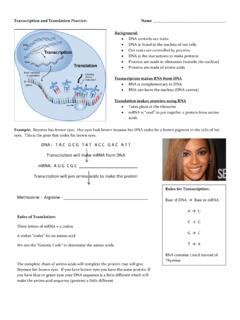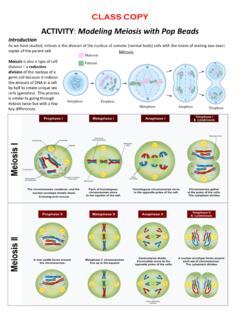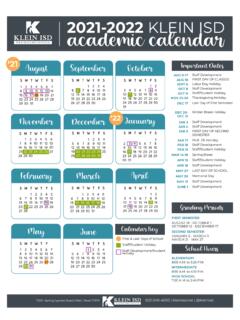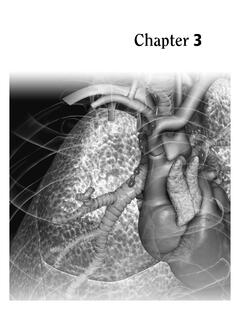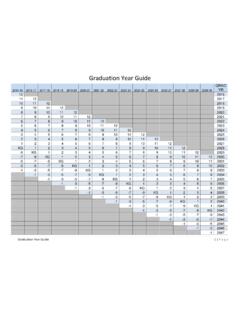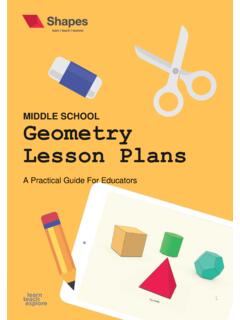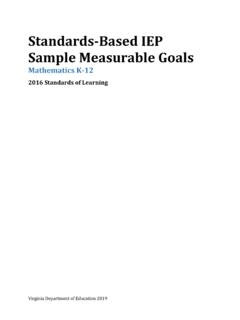Transcription of A Story of Ratios - SharpSchool
1 A Story of Ratios . Eureka Math . Grade 7, Module 3. Teacher Edition Published by the non-profit Great Minds Copyright 2015 Great Minds. All rights reserved. No part of this work may be reproduced or used in any form or by any means graphic, electronic, or mechanical, including photocopying or information storage and retrieval systems without written permission from the copyright holder. Great Minds and Eureka Math are registered trademarks of Great Minds. Printed in the This book may be purchased from the publisher at 10 9 8 7 6 5 4 3 2 1. A Story OF Ratios . 7. GRADE. Mathematics Curriculum GRADE 7 MODULE 3. Table of Contents1. Expressions and Equations Module Overview .. 3.
2 Topic A: Use Properties of Operations to Generate Equivalent Expressions ( , ) .. 12. Lessons 1 2: Generating Equivalent Expressions .. 13. Lessons 3 4: Writing Products as Sums and Sums as Products .. 48. Lesson 5: Using the Identity and Inverse to Write Equivalent 73. Lesson 6: Collecting Rational Number Like 85. Topic B: Solve Problems Using Expressions, Equations, and Inequalities ( , , ) .. 98. Lesson 7: Understanding Equations .. 100. Lessons 8 9: Using If-Then Moves in Solving Equations .. 113. Lessons 10 11: Angle Problems and Solving Equations .. 150. Lesson 12: Properties of Inequalities .. 171. Lesson 13: Inequalities .. 184. Lesson 14: Solving Inequalities .. 193.
3 Lesson 15: Graphing Solutions to Inequalities .. 203. Mid-Module Assessment and Rubric .. 217. Topics A through B (assessment 2 days, return 1 day, remediation or further applications 2 days). Topic C: Use Equations and Inequalities to Solve Geometry Problems ( , ) .. 239. Lesson 16: The Most Famous Ratio of All .. 241. Lesson 17: The area of a Circle .. 252. Lesson 18: More Problems on area and Circumference .. 262. Lesson 19: Unknown area Problems on the Coordinate Plane .. 273. Lesson 20: Composite area Problems .. 283. Lessons 21 22: Surface area .. 295. Lessons 23 24: The volume of a Right Prism .. 320. 1 Each lesson is ONE day, and ONE day is considered a 45-minute period.
4 Module 3: Expressions and Equations 1. This work is derived from Eureka Math and licensed by Great Minds. 2015 Great Minds. A Story OF Ratios Module Overview 7 3. Lessons 25 26: volume and Surface 342. End-of-Module Assessment and Rubric .. 364. Topics A through C (assessment 1 day, return 1 day, remediation or further applications 2 days). Module 3: Expressions and Equations 2. This work is derived from Eureka Math and licensed by Great Minds. 2015 Great Minds. A Story OF Ratios Module Overview 7 3. Grade 7 Module 3. Expressions and Equations OVERVIEW. In Grade 6, students interpreted expressions and equations as they reasoned about one-variable equations ( ). This module consolidates and expands upon students' understanding of equivalent expressions as they apply the properties of operations (associative, commutative, and distributive) to write expressions in both standard form (by expanding products into sums) and in factored form (by expanding sums into products).
5 They use linear equations to solve unknown angle problems and other problems presented within context to understand that solving algebraic equations is all about the numbers. It is assumed that a number already exists to satisfy the equation and context; we just need to discover it. A number sentence is an equation that is said to be true if both numerical expressions evaluate to the same number; it is said to be false otherwise. Students use the number line to understand the properties of inequality and recognize when to preserve the inequality and when to reverse the inequality when solving problems leading to inequalities. They interpret solutions within the context of problems.
6 Students extend their sixth-grade study of geometric figures and the relationships between them as they apply their work with expressions and equations to solve problems involving area of a circle and composite area in the plane, as well as volume and surface area of right prisms. In this module, students discover the most famous ratio of all, , and begin to appreciate why it has been chosen as the symbol to represent the Grades 6 8 mathematics curriculum, A Story of Ratios . To begin this module, students will generate equivalent expressions using the fact that addition and multiplication can be done in any order with any grouping and will extend this understanding to subtraction (adding the inverse) and division (multiplying by the multiplicative inverse, also known as the reciprocal).
7 ( ). They extend the properties of operations with numbers (learned in earlier grades) and recognize how the same properties hold true for letters that represent numbers. Knowledge of rational number operations from Module 2 is demonstrated as students collect like terms containing both positive and negative integers. An area model is used as a tool for students to rewrite products as sums and sums as products and to provide a visual representation leading students to recognize the repeated use of the distributive property in factoring and expanding linear expressions ( ). Students examine situations where more than one form of an expression may be used to represent the same context, and they see how looking at each form can bring a new perspective (and thus deeper understanding) to the problem.
8 Students recognize and use the identity properties and the existence of additive inverses to efficiently write equivalent expressions in standard form, for example, 2 + ( 2 ) + 3 = 0 + 3 = 3 ( ). By the end of the topic, students have the opportunity to practice knowledge of operations with rational numbers gained in Module 2 ( , ) as they collect like terms with rational number coefficients ( ). In Topic B, students use linear equations and inequalities to solve problems ( ). They continue to use tape diagrams from earlier grades where they see fit, but will quickly discover that some problems would more reasonably be solved algebraically (as in the case of large numbers).
9 Guiding students to arrive at this Module 3: Expressions and Equations 3. This work is derived from Eureka Math and licensed by Great Minds. 2015 Great Minds. A Story OF Ratios Module Overview 7 3. realization on their own develops the need for algebra. This algebraic approach builds upon work in Grade 6. with equations ( , ) to now include multi-step equations and inequalities containing rational numbers ( , ). Students solve problems involving consecutive numbers; total cost; age comparisons; distance, rate, and time; area and perimeter; and missing angle measures. Solving equations with a variable is all about numbers, and students are challenged with the goal of finding the number that makes the equation true.
10 When given in context, students recognize that a value exists, and it is simply their job to discover what that value is. Even the angles in each diagram have a precise value, which can be checked with a protractor to ensure students that the value they find does indeed create a true number sentence. In Topic C, students continue work with geometry as they use equations and expressions to study area , perimeter, surface area , and volume . This final topic begins by modeling a circle with a bicycle tire and comparing its perimeter (one rotation of the tire) to the length across (measured with a string) to allow students to discover the most famous ratio of all, pi. Activities in comparing circumference to diameter are staged precisely for students to recognize that this symbol has a distinct value and can be approximated by 22.

